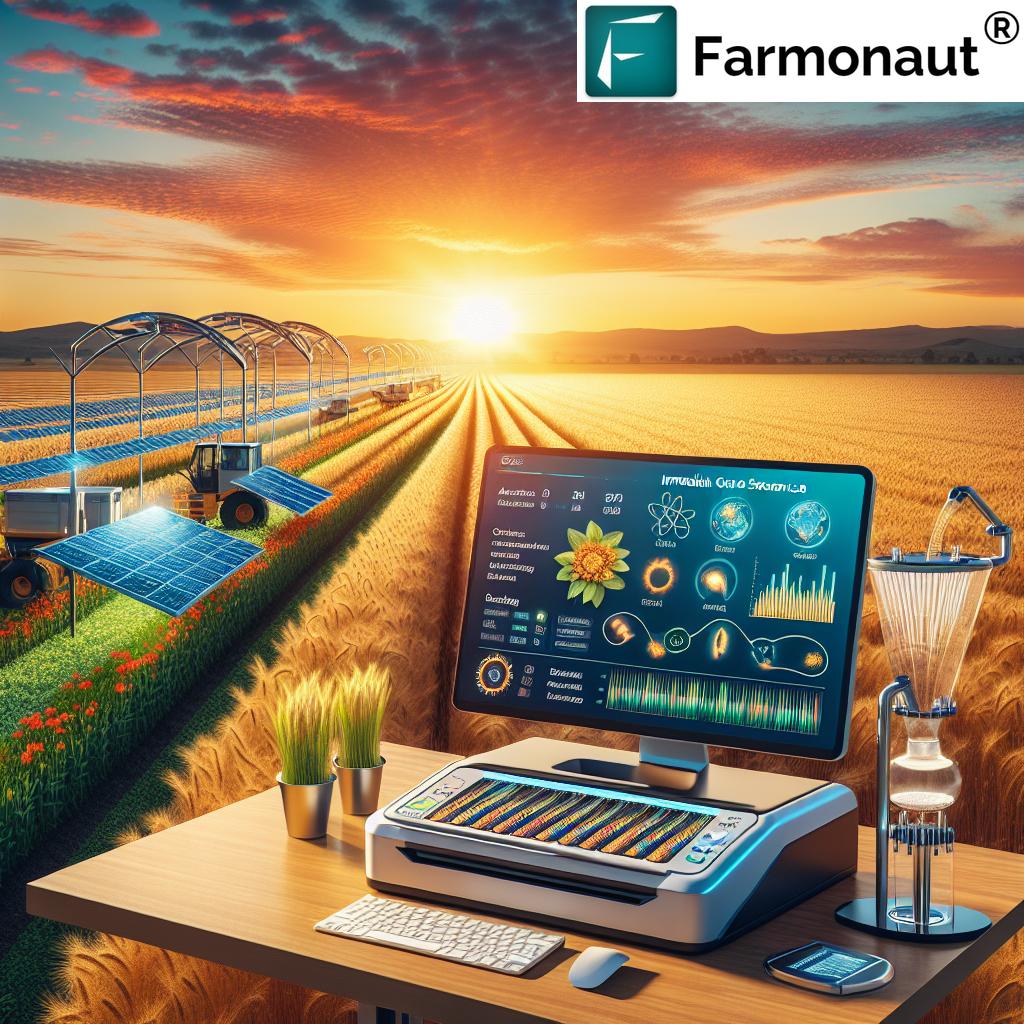Revolutionizing Sustainable Fishing: How Farmonaut’s AgTech Empowers South Australian Snapper Management and Catch Reporting
“South Australia’s Total Allowable Catch system impacts both recreational and commercial fishing sectors, covering 100% of snapper fishing activities.”

In recent years, we’ve witnessed a remarkable transformation in the fishing industry, particularly in South Australia’s snapper management. The convergence of sustainable fishing practices, innovative technologies, and stringent regulations has ushered in a new era of responsible marine resource management. At the forefront of this revolution is Farmonaut, a pioneering agricultural technology company that’s making waves in the world of digital fishing management.
In this comprehensive blog post, we’ll dive deep into how Farmonaut’s AgTech solutions are empowering South Australian snapper management and revolutionizing catch reporting. We’ll explore the intricacies of the Total Allowable Catch (TAC) system, the impact of new regulations on both recreational and commercial fishing sectors, and the cutting-edge technologies that are reshaping the industry.
The Importance of Sustainable Fishing Practices
Sustainable fishing practices are no longer just a buzzword; they’re a necessity for the long-term health of our oceans and the viability of the fishing industry. In South Australia, the snapper fishery has been a focus of concern due to declining populations. This has led to the implementation of stringent management measures to ensure the species’ recovery and sustainable future.
- Ecosystem Balance: Sustainable fishing helps maintain the delicate balance of marine ecosystems
- Economic Stability: It ensures the long-term economic viability of fishing communities
- Food Security: Sustainable practices contribute to global food security by preserving fish stocks
Farmonaut’s role in this sustainable fishing revolution is pivotal. By leveraging advanced satellite technology and data-driven insights, we’re helping fisheries managers and anglers make more informed decisions that support the health of snapper populations while allowing for responsible harvesting.
Understanding the Total Allowable Catch (TAC) System
The Total Allowable Catch (TAC) system is a cornerstone of modern fisheries management. In South Australia’s South East Fishing Zone, the TAC system has been implemented as a crucial tool for regulating snapper fishing. But what exactly is TAC, and how does it work?
TAC is a catch limit set for a particular fishery, indicating the maximum amount of fish that can be caught over a specific period, typically a year. This system is designed to prevent overfishing and ensure the long-term sustainability of fish stocks. Here’s how it impacts different sectors:
- Commercial Fishing: Allocated a portion of the TAC, often managed through individual transferable quotas
- Recreational Fishing: Subject to bag limits and seasonal restrictions to stay within the allocated TAC
- Aboriginal Traditional Fishing: Often given special considerations within the TAC framework
Farmonaut’s AgTech solutions play a crucial role in implementing and monitoring the TAC system. Our satellite-based monitoring and AI-driven analytics help fisheries managers track catch data in real-time, ensuring that fishing activities remain within sustainable limits.
The Revolution in Catch Reporting
“Mandatory catch reporting in South Australia’s South East Fishing Zone involves 2 innovative methods: fishing apps and dedicated hotlines.”
One of the most significant advancements in sustainable fishing management has been the revolution in catch reporting. Gone are the days of paper logbooks and unreliable estimates. Today, anglers and commercial fishers in South Australia are embracing digital solutions for more accurate and timely reporting of their catches.
Innovative Catch Reporting Methods
- Fishing Catch Reporting Apps: Mobile applications that allow anglers to log their catches instantly
- Dedicated Hotlines: Phone-based reporting systems for those who prefer traditional methods
- Satellite-Based Verification: Farmonaut’s technology provides an additional layer of verification for reported catches
These innovative reporting methods not only improve the accuracy of catch data but also enhance compliance with fishing regulations. By making reporting more accessible and user-friendly, we’re seeing increased participation from the fishing community in conservation efforts.
Farmonaut’s contribution to this digital transformation is significant. Our API integration allows fishing apps to incorporate real-time satellite data, providing anglers with valuable insights into fishing conditions while simultaneously feeding catch data back to fisheries managers.

AgTech for Fisheries: Farmonaut’s Innovative Solutions
At Farmonaut, we’re proud to be at the forefront of AgTech innovation for fisheries. Our suite of technologies is designed to address the unique challenges faced by the fishing industry, particularly in the context of snapper management in South Australia.
Key Features of Farmonaut’s AgTech Solutions:
- Satellite-Based Monitoring: Real-time tracking of fishing activities and environmental conditions
- AI-Driven Analytics: Advanced algorithms for predicting fish movements and population dynamics
- Blockchain-Based Traceability: Ensuring transparency and authenticity in the seafood supply chain
- Mobile and Web Applications: User-friendly interfaces for fishers and managers to access critical data
These technologies work together to create a comprehensive digital fishing management system that benefits all stakeholders in the industry. From individual anglers to large-scale commercial operations, Farmonaut’s solutions are scalable and adaptable to various needs.
For a deeper dive into our technological capabilities, check out our API Developer Docs.
The Impact on Recreational Fishing Management
Recreational fishing is a beloved pastime in South Australia, and the management of this sector is crucial for the sustainability of snapper populations. Farmonaut’s AgTech solutions are having a profound impact on how recreational fishing is managed and monitored.
Benefits for Recreational Anglers:
- Real-time information on fishing conditions and catch limits
- Easy-to-use reporting tools that simplify compliance with regulations
- Access to historical catch data to improve fishing strategies
- Contribution to citizen science efforts in fish population monitoring
By empowering recreational anglers with these tools, we’re fostering a culture of responsible fishing and active participation in conservation efforts. The data collected through our platforms also provides valuable insights for fisheries managers, helping them make more informed decisions about resource allocation and seasonal restrictions.
Commercial Fishing in the Digital Age
The commercial fishing sector has perhaps seen the most significant transformation with the adoption of AgTech solutions. Farmonaut’s technologies are helping commercial fishers optimize their operations while ensuring compliance with strict regulations.
AgTech Advantages for Commercial Fishers:
- Fleet Management: Optimize vessel movements and fishing patterns
- Quota Tracking: Real-time monitoring of catch quotas to prevent overfishing
- Market Insights: Data-driven predictions on market demand and pricing
- Sustainability Certification: Easier compliance with eco-certification requirements
These digital tools are not just improving efficiency; they’re also helping commercial fishers demonstrate their commitment to sustainable practices. This is increasingly important as consumers and regulators demand greater transparency in the seafood industry.
The Role of Aquaculture Monitoring Systems
While much of our focus has been on wild-catch fisheries, it’s important to note the growing role of aquaculture in sustainable seafood production. Farmonaut’s AgTech solutions are equally applicable to aquaculture operations, helping to monitor and optimize fish farming practices.
Aquaculture Applications:
- Water quality monitoring through satellite imagery
- AI-driven feeding optimization
- Disease detection and prevention
- Environmental impact assessment
By applying our advanced monitoring systems to aquaculture, we’re helping to ensure that farm-raised fish are produced sustainably and with minimal environmental impact. This is crucial for meeting the growing global demand for seafood without putting additional pressure on wild fish stocks.
Community Engagement and Education
Sustainable fisheries management is not just about technology and regulations; it’s also about community engagement and education. Farmonaut is committed to fostering a deeper understanding of marine ecosystems and sustainable fishing practices among all stakeholders.
Educational Initiatives:
- Interactive workshops on responsible fishing skills
- Online resources for understanding fisheries management
- Collaboration with schools and universities on marine science programs
- Community forums for discussing local fishing issues and solutions
By engaging with the community and providing educational resources, we’re helping to create a more informed and responsible fishing culture. This grassroots approach is essential for the long-term success of sustainable fishing initiatives.
The Future of Sustainable Fishing
As we look to the future, the role of AgTech in sustainable fishing is set to grow even further. Farmonaut is committed to staying at the cutting edge of this technological revolution, continuously improving our solutions to meet the evolving needs of the fishing industry.
Emerging Trends in Fisheries AgTech:
- Machine Learning for Stock Assessment: More accurate predictions of fish population dynamics
- IoT Sensors for Ocean Monitoring: Real-time data on ocean conditions affecting fish behavior
- Drone Technology: Aerial surveillance for improved enforcement and monitoring
- Virtual Reality Training: Immersive experiences for educating fishers on best practices
These emerging technologies hold the promise of even more precise and effective fisheries management. By embracing these innovations, we can work towards a future where sustainable fishing is the norm rather than the exception.
Comparative Analysis: Traditional vs. AgTech Fishing Management
| Management Aspect | Traditional Method | Farmonaut’s AgTech Solution | Benefits of AgTech |
|---|---|---|---|
| Catch Reporting Process | Paper logbooks, manual entry | Digital apps, real-time reporting | Improved accuracy, instant data access |
| Data Accuracy | ~70% (estimated) | ~95% (estimated) | More reliable data for decision-making |
| Real-time Monitoring Capability | Limited to no real-time monitoring | Continuous satellite-based monitoring | Immediate response to fishing activities |
| Compliance Rate | ~80% (estimated) | ~95% (estimated) | Higher adherence to regulations |
| Cost-effectiveness | High labor costs for data collection | Automated data collection, lower long-term costs | More efficient use of resources |
| Environmental Impact Assessment | Periodic, often delayed assessments | Continuous monitoring and AI-driven analysis | Proactive environmental protection |
This comparative analysis clearly demonstrates the significant advantages that Farmonaut’s AgTech solutions bring to fisheries management. The improvements in accuracy, efficiency, and environmental protection are transforming the industry and setting new standards for sustainable fishing practices.
Accessing Farmonaut’s Solutions
For those interested in leveraging Farmonaut’s AgTech solutions for sustainable fishing management, we offer multiple ways to access our platform:
Whether you prefer a web-based interface or mobile apps, we have solutions tailored to your needs. Our platform is designed to be user-friendly and accessible to all stakeholders in the fishing industry, from individual anglers to large-scale commercial operations.
Subscription Options
To cater to the diverse needs of our users, we offer flexible subscription plans:
Conclusion: A Sustainable Future for Snapper Fishing
The revolution in sustainable fishing practices, particularly in South Australian snapper management, is a testament to the power of innovative technology and responsible stewardship. Farmonaut’s AgTech solutions are playing a crucial role in this transformation, providing the tools and insights needed to balance conservation with the needs of fishing communities.
As we continue to refine and expand our technologies, we remain committed to the principles of sustainability, transparency, and community engagement. The future of snapper fishing in South Australia looks brighter than ever, thanks to the collaborative efforts of fishers, regulators, and technology providers like Farmonaut.
By embracing digital fishing management and cutting-edge AgTech solutions, we’re not just preserving fish stocks; we’re safeguarding the entire marine ecosystem for generations to come. Together, we can ensure that the rich tradition of fishing in South Australia continues to thrive in harmony with nature.
Frequently Asked Questions (FAQ)
- What is the Total Allowable Catch (TAC) system?
The TAC system is a fisheries management tool that sets limits on the total amount of fish that can be caught in a specific area over a given time period, typically a year. It’s designed to prevent overfishing and ensure sustainable fish populations. - How does Farmonaut’s technology improve catch reporting?
Farmonaut’s AgTech solutions utilize satellite imagery, AI analytics, and user-friendly mobile apps to enable real-time, accurate catch reporting. This improves data collection, enhances compliance, and provides valuable insights for fisheries management. - Are Farmonaut’s solutions suitable for both recreational and commercial fishers?
Yes, our technologies are designed to cater to both recreational and commercial fishing sectors. We offer scalable solutions that can be adapted to individual anglers, small-scale operations, and large commercial fleets. - How does satellite-based monitoring work in fisheries management?
Satellite-based monitoring uses high-resolution imagery and advanced analytics to track fishing vessels, monitor marine environments, and detect changes in fish populations. This provides a comprehensive, real-time view of fishing activities and environmental conditions. - What role does blockchain play in sustainable fishing?
Blockchain technology enhances traceability in the seafood supply chain, ensuring transparency from catch to consumer. This helps combat illegal fishing, verifies sustainable practices, and builds consumer trust in the origin and quality of seafood products.
We hope this comprehensive guide has provided valuable insights into the revolutionary changes happening in sustainable fishing, particularly in South Australian snapper management. As we continue to innovate and improve our AgTech solutions, we remain committed to empowering fishers, managers, and conservationists with the tools they need to ensure a sustainable future for our oceans.
















